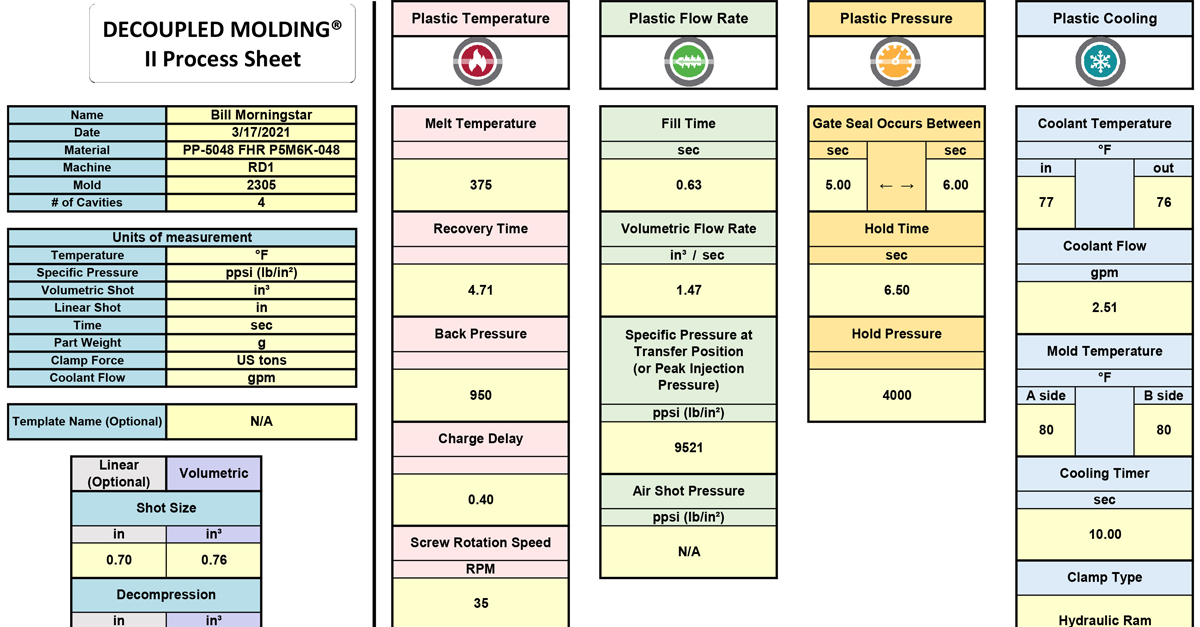Decoupled molding is defined as a process of molding where the filling stage is separated from the packing and holding stage. Decoupled molding looks at each critical molding process component separately and scientifically to determine the best possible molding parameters – it evaluates the fill, pack, and hold parameters. Decoupling these stages allows for greater process repeatability and consistency, as well as improved part quality.
Stages of decoupled molding
There are several stages of decoupled molding. It is subdivided into three phases (Decoupled I, Decoupled II, and Decoupled III).
Decoupled I
This method was first utilized in the early 1970s to help control cavity pressure. With this method, the mold is attentively and gradually filled until it is full. The machine for this stage is set to a holding pressure, and the molten material's momentum is used in the molding pack process. Filling and packing are two different things, but the fill from stage one impacts the pack process most.
Decoupled II
Decouple II focuses on fill rates to achieve a consistent molding process. This requires a quickly filling rate to take advantage of rheology and reach faster fill rates. Doing so requires you to isolate the filling and packing processes totally. If you don't keep the rapid fill from being connected with the abrupt process end at the infilling of the cavity, flash will occur as a result of melt inertia.
It is best to slow down right before coming to the close of the cavity so that the quick fill stage is separate from the pack step. With Decouple II process, all of this can be done by switching from the fill stage to the pressure step while the mold form is between 95 and 98 percent full.
In other words, you can fill the mold as quickly or as slowly as you want, as long as you pause to let the molten material's inertia dissipate before packing it into the mold. This becomes a Decouple II fundamental principle. The packing process and holding are related, even though packing happens during stage two. The packing speed isn't directly controlled – it depends on the pressure in the second stage. That pressure is then regulated to hold the part and pack to avoid collision with the cavity's end.
Decoupled III
The newest advancement in decoupled molding process is the division of the stages into three different steps: fill stage, pack stage, and hold stage. The fill stage can be achieved at various speeds (depending on the part’s geometry).
Decoupling the packing step from the next step, the filling stage, allows for plastic to be squeezed under pressure at stage two at a much slower, controlled velocity. By performing packing this way and reaching a set point of pressure within the cavity, you can achieve desired packing levels while absorbing the majority of molten inertia. After the plastic is inserted into the mold, hold is employed to keep it from flowing back and blocking the gate.
Benefits of using decoupled molding
Decoupled injection molding offers many potential benefits for plastic parts manufacturers. These benefits can result in increased production efficiency and more consistent product quality. The following are some of the potential benefits of decoupled injection molding.
Reduced cycle time
The decoupled molding process decouples the injection and molding stages, which can lead to a shorter cycle time.
Improved part quality
Decoupled molding can result in improved part quality due to the decoupled nature of the process. This decoupling can allow for better control over the injection molding process, leading to more consistent part quality.
Reduced scrap and rejects rates
Decoupled molding reduces scrap and rejects rates due to its scientific approach that eliminates process variability. The decoupled molding process can also improve the consistency of the final product, which can lead to fewer rejects.
To learn more about scientific injection molding principles, read this white paper!
Why choose Crescent Industries as your injection molding partner?
If you are looking for an injection molding partner that uses decoupled molding to provide a better manufacturing product, Crescent Industries is here to help. Our advanced engineering capabilities and an integrated, single-source solution will provide you with the molded components you need. To learn more about our company and how we can serve your needs, please visit our website or contact us today.
Sources
Almanac: The fundamentals of Decoupled MoldingDecoupled Molding(SM)
Technology at Work: How RJG’s Decoupled Molding℠ Provides Superior Quality
DECOUPLED MOLDING(SM) for Process Capability - Part 1
INJECTION MOLDING: COMPLETE GUIDE TO SCIENTIFIC MOLDING


